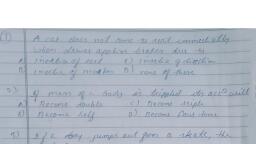Question 1 :
_______ of a body changes from place to place but its ______ remains constant.
Question 2 :
Specific gravity of the body is numericallyequal to ________of the body.
Question 3 :
Assertion: A man is sitting in a boat which is floating on a pond. If the man drinks some water from the pond, the level of water in the pond decreases.
Reason: The volume of water in the pond decreases.
Question 4 :
Which on of the following would a hydrogen balloon find easiest to lift?
Question 5 :
The mass of an wooden cube of edge 10 cm is 800 g. If the mass of an equal volume of water is 1 kg, then find the relative density of a wooden cube.<br>
Question 6 :
If the radius of the earth is increased by three times, keeping the mass constant, then the weight of a body on the earth surface will be ______ as compared to its previous value.<br/>
Question 7 :
If $M$ is the mass of the earth and $R$ its radius, the ratio of the gravitational acceleration and the gravitational constant is:<br/>
Question 8 :
The mass of a planet is 4 times while its radius is 8 times that of the earth. If the weight of an object is 640 N on earth, what will be its weight on the planet?<br>
Question 9 :
A rectangular iron block is kept over a table with different faces touching the table. In different cases, the block exerts :
Question 10 :
The value of g at a particular point is 9.8 $ms^{-2}$. Suppose the earth suddently shrinks uniformly to half its present size without losing any mass. The value of g at the same point (distance of the point from the centre of earth does not change) will now be<br>
Question 11 :
Two balls are dropped from the same height from places $A$ and $B$. The body at $B$ takes two seconds less to reach the ground at $B$ strikes the ground with a velocity greater than at $A$ by $10 m/s$. The product of the acceleration due to gravity at the two places $A$ and $B$ is:
Question 13 :
The maximum vertical distance through which a fully dressed astronaut can jump on the earth is 0.5 m. If mean density of the moon is two thirds that of the earth and radius is one quarter that of the earth, the maximum vertical distance through which he can jump on the moon and the ratio of time of duration of the jump on the moon to that on the earth are.
Question 14 :
A spherical planet, far out in space, has a mass $M_0$ and diameter $D_0$. A particle of mass $m$ falling freely near the surface of this planet will experience acceleration due to gravity which is equal to:
Question 15 :
A ball with a weight of 20 N is thrown vertically upward . What is the acceleration of the ball just as it reaches the top of its path ?



































































